I have XYZ data. X and Y are coordinates of some random points inside a star-shaped domain. I want to plot a heatmap for this data. The objective is to reproduce this figure in matplotlib:
I have already tried the two solutions proposed for this and this question. None of them worked.
The coordinates of the star are as follows:
coords= [(0.5, 0.0), (0.8660254037844387, 0.49999999999999994), (0.25000000000000006, 0.4330127018922193), (6.123233995736766e-17, 1.0), (-0.2499999999999999, 0.43301270189221935), (-0.8660254037844385, 0.5000000000000003), (-0.5, 6.123233995736766e-17), (-0.8660254037844388, -0.4999999999999997), (-0.2500000000000002, -0.4330127018922192), (-1.8369701987210297e-16, -1.0), (0.24999999999999967, -0.4330127018922195), (0.8660254037844384, -0.5000000000000004), (0.5, -1.2246467991473532e-16)]
Let's
X=array([-0.10885458, 0.38719084, 0.126246 , 0.32831633, -0.43470323,
-0.14589308, 0.03527489, -0.30802489, 0.03631802, -0.6407443 ,
0.1420586 , -0.04242902, 0.56713419, 0.03697127, 0.56324232,
-0.17307027, 0.23414952, -0.1249898 , 0.10993816, -0.15574171,
0.22480668, -0.16938372, 0.46415079, 0.05454076, 0.63360403,
-0.43812225, 0.39817569, -0.31963035, -0.31926434, 0.16913435,
0.68687168, -0.14839105, 0.53042922, -0.04944691, -0.20848955,
0.60348851, -0.23746634, -0.00968032, -0.63404439, -0.05204527,
0.27697056, -0.0023835 , -0.60480204, -0.29335925, 0.08750121,
0.13853292, 0.01434203, -0.51095204, 0.17537239, -0.21610341])
and
Y = array([-0.10566327, 0.36444335, 0.50664288, 0.34520176, 0.12666237,
0.24523639, 0.45936775, 0.36855297, -0.89093646, 0.25080176,
-0.21871761, 0.56413549, -0.37842424, -0.85040143, 0.28691973,
-0.02916441, 0.20025945, -0.25469069, 0.52055077, -0.23973923,
-0.03349382, -0.4850852 , -0.22147722, 0.82357372, 0.19736351,
0.16366808, -0.30763208, -0.07932644, 0.18458957, 0.19116663,
-0.37589083, -0.62173701, -0.08265561, 0.28642521, -0.3096187 ,
0.18280694, 0.0287418 , -0.35277588, 0.41465303, 0.77087622,
-0.20084426, 0.72120447, -0.29936638, 0.39579946, 0.35693334,
0.41785566, -0.39066645, 0.01689062, 0.25396642, 0.12154352])
and
Z = array([0.36857377, 0.08481739, 0.08529314, 0.09577443, 0.12750615,
0.22158901, 0.18614892, 0.0703758 , 0.0111191 , 0.03745636,
0.24347694, 0.13703608, 0.08855241, 0.03235803, 0.11979384,
0.33964959, 0.23354923, 0.23385712, 0.09479431, 0.22835837,
0.29181292, 0.0550857 , 0.15981413, 0.02425207, 0.01008352,
0.14666378, 0.14105369, 0.20266958, 0.25451451, 0.25561241,
0.07160838, 0.0181599 , 0.02512438, 0.25329402, 0.14160124,
0.02455915, 0.275493 , 0.25261528, 0.05976918, 0.04502752,
0.23377016, 0.11031544, 0.09229812, 0.04252507, 0.1807899 ,
0.11100155, 0.23271334, 0.00184005, 0.19467501, 0.31437854])
I think the problem is that the shape is not convex and that's why most of the interpolation methods fail. Your thoughts would be appreciated.

